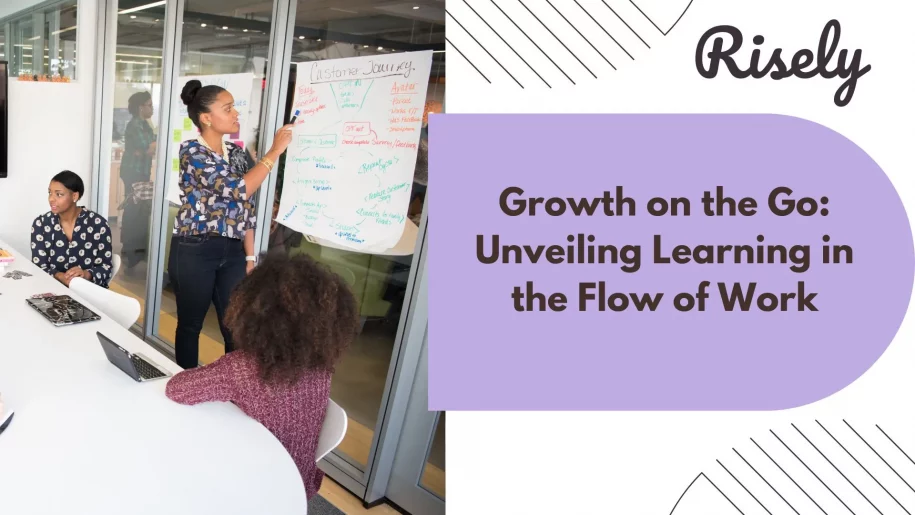Growth on the Go: Unveiling Learning in the Flow of Work
The concept of learning has evolved beyond traditional training sessions. “Learning in the Flow of Work,” a revolutionary approach that seamlessly integrates learning opportunities into employees’ daily tasks and routines. This approach recognizes that the most effective learning occurs when it’s relevant, immediate, and directly applicable to the challenges. In this blog, we will delve into the concept of learning in the flow of work, exploring its benefits strategies and how it transforms how organizations nurture continuous growth and development among their workforce.What is learning in the flow of work?
Learning in the flow of work, often referred to as “learning in the flow,” is a concept that aims to seamlessly integrate learning opportunities into the daily tasks, activities, and routines of employees within their work environment. Instead of traditional learning methods separate from work, learning in the flow of work brings relevant and targeted learning experiences directly to employees while performing their job tasks. This approach leverages technology, automation, and data to deliver learning content, resources, and support at the right moment and context, enabling employees to acquire new knowledge and skills in real time. It provides immediate solutions, insights, and guidance to enhance productivity, problem-solving, and decision-making. This aims to make learning a natural part of employees’ work experiences, enhancing their performance, adaptability, and overall growth without disrupting their workflow. It aligns with the principle that continuous learning should be easily accessible and seamlessly integrated into the daily routine, ultimately contributing to individual and organizational success.Why is learning in the flow of work important?
Learning in the flow of work is essential for several compelling reasons:- Real-time relevance: Traditional learning methods often involve separate training sessions that may not address immediate needs. This delivers relevant information exactly when employees need it, making learning more impactful and applicable.
- Increased efficiency: Integrating learning into work tasks minimizes employees’ time searching for information or solutions. This leads to greater efficiency and productivity, as they can quickly access the knowledge required to complete their tasks.
- Seamless integration: Learning in the flow of work seamlessly blends into employees’ daily routines. This eliminates the need for separate learning sessions, making employees more likely to engage with learning content consistently.
- Enhanced retention: Learning that occurs in context is often better retained. When employees immediately apply newly acquired knowledge or skills to their tasks, they reinforce their learning through practice and experience.
- Adaptability: The pace of change in the modern workplace requires employees to update their skills and knowledge continually. Learning in the flow of work allows them to stay current with minimal disruption, fostering adaptability.
- Continuous Improvement: As employees engage in ongoing learning within their work processes, they can identify areas for improvement and apply newly acquired insights in real time.
Advantages of learning in the flow of work
Learning in the flow of work offers numerous advantages that contribute to individual and organizational growth and success. Some key benefits are:- Efficiency: Learning in real-time reduces the time spent searching for information or attending separate training sessions, resulting in enhanced efficiency.
- Engagement: Learning opportunities integrated into work processes increase employee engagement and motivation as they see the immediate benefits of their learning efforts.
- Personalization: Technology can analyze employees’ behavior and preferences to deliver customized learning content catering to individual needs.
- Cost-effective: Learning in the flow of work eliminates the need for separate training sessions, saving time and resources while providing targeted learning outcomes.
- Organizational agility: A workforce that can quickly acquire new skills and knowledge enhances an organization’s ability to respond to market changes and challenges.
- Positive culture: Prioritizing learning within work processes signals an organization’s commitment to employee growth, fostering a positive, learning-oriented culture.
- Skill diversity: Employees can easily explore new skills and knowledge areas that might not have been part of their initial job description, contributing to skill diversification.
- Reduced skill gap: Learning in the flow of work ensures that employees are up-to-date with the latest skills, reducing the gap between required and existing competencies.
- Alignment with goals: Learning interventions can be directly aligned with organizational goals, ensuring that employees are equipped to contribute to strategic objectives.
Other Interesting Reads
Learning in the flow of work examples
Learning in the flow of work can take various forms, seamlessly integrating learning opportunities into daily tasks and routines. Here are some examples:- On-demand resources: Providing employees with quick access to resources like video tutorials, infographics, or knowledge articles that offer solutions to immediate challenges.
- Microlearning modules: Delivering short, focused learning modules that employees can complete during breaks or downtime, addressing specific topics or skills.
- In-app guidance: Incorporating tooltips, pop-ups, or help features within software applications to guide employees as they perform tasks.
- Virtual coaches: Implementing virtual assistants or chatbots that can answer questions, provide guidance, and offer suggestions based on the user’s context.
- Feedback loops: Incorporating feedback mechanisms that provide real-time insights and suggestions for improvement as employees complete tasks.
- Case Studies: Presenting real-world scenarios and case studies that employees can analyze to gain insights into best practices and decision-making.
- Just-in-time learning: Providing immediate access to learning content when employees encounter challenges or have questions during their tasks.
- Gamification: Incorporating game elements, such as quizzes, challenges, or rewards, to engage employees in learning while completing tasks.
Best practices for embedding learning in the flow of work
Embedding learning in the flow of work requires a strategic approach to ensure its effectiveness and seamless integration. Some best practices to consider:- Understand user needs: Begin by understanding your target audience’s specific tasks, challenges, and needs. Identify where learning interventions can add the most value.
- Align with goals: Ensure learning interventions align with organizational goals, team objectives, and individual development plans.
- User-centric design: Develop learning experiences that are user-centric, intuitive, and easily accessible within the context of work tasks.
- Microlearning: Focus on delivering bite-sized, focused learning content that can be quickly consumed and applied without disrupting work.
- Relevance: Ensure that learning content is directly relevant to employees’ tasks, addressing their immediate needs.
- Integration with tools: Integrate learning content seamlessly into the tools and software applications employees use daily, such as email clients, project management platforms, or customer relationship management (CRM) systems.
- Timely delivery: Deliver learning content at the right moment in the workflow when employees are most likely to need it.
- Mobile accessibility: Ensure learning content is accessible on mobile devices, allowing employees to learn on the go and when it’s most convenient.
- Manager support: Involve managers in encouraging employees to engage with learning content and apply it effectively.
Conclusion
In conclusion, learning in the flow of work represents a paradigm shift in how organizations approach employee development. This approach maximizes relevance, retention, and application by seamlessly integrating learning opportunities into the fabric of daily tasks. As we’ve explored, the benefits are substantial – from improved performance and efficiency to a culture of continuous learning. As businesses strive to remain agile and competitive, embracing learning in the flow of work becomes a strategic imperative. By nurturing skills and knowledge within the context of employees’ existing routines, organizations empower their workforce to grow, adapt, and excel in an ever-evolving landscape. As we move forward, remember that the key to success lies in aligning learning with work, creating a harmonious synergy that drives innovation and propels individuals and organizations toward ongoing success.Ready to supercharge your team’s growth?
Take our free expectation-setting assessment and discover how learning in the flow of work can drive success like never before. Start now!
Other Related Blogs
How to Set Effective Learning and Development Goals?
This blog highlights how effective learning and development goals are set, why is setting them important for your organization and what challenges you might face during this process. … Read…
Are you on track to meet your Q1 goals?
Are you on track to meet your Q1 goals? We are in the middle of the first quarter of 2024. Seems hard to believe. It surely is! ⏰ Time has…
5 Secrets Of Solid Goal Setting At Work You Can’t Miss
5 Secrets Of Solid Goal Setting At Work You Can’t Miss “I don’t focus on what I’m up against. I focus on my goals and I try to ignore the…
Understanding the world of Goal Setting Coach to reach new heights
Understanding the world of Goal Setting Coach to reach new heights Setting and achieving goals is essential for personal and organizational success in today’s fast-paced and competitive work environment. However,…


